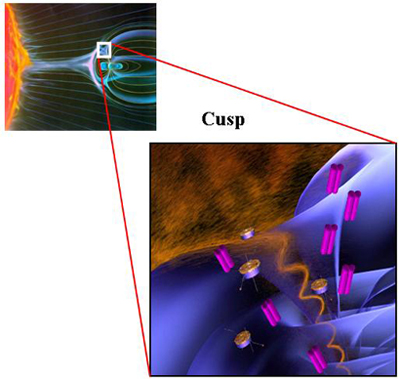From 'macro' to 'micro': turbulence seen by Cluster
11 August 2005
Thanks to measurements by ESA's Cluster mission, a team of European scientists have identified 'micro' -vortices in Earth's magnetosphere. Such small-scale vortex turbulence, whose existence was predicted through mathematical models, has not been observed before in space. The results are not only relevant for space physics, but also for other applications like research on nuclear fusion.On 9 March 2002, the four Cluster satellites, flying in tetrahedral formation at 100 kilometres distance from each other, were crossing the northern magnetic cusp when they made their discovery. Magnetic cusps are the regions over the magnetic poles where the magnetic field lines surrounding Earth form a magnetic funnel.
 |
|
An illustration depiciting the spacecraft formation (in close-up) and the loction of the disturbance in the northern magnetic cusp. |
The magnetic cusps are the two important regions in Earth’s magnetosphere where the solar wind - a constant flow of charged particles generated by the Sun that crosses the whole Solar System - can directly access the upper layer of Earth’s atmosphere (the ionosphere).
Large amounts of plasma (a gas of charged particles) and energy are transported through these and other accessible regions, to penetrate the magnetosphere - Earth’s natural protective shield. Only less than one percent of all the energy carried by the solar wind and hitting the Earth’s magnetosphere actually manages to sneak through, but it still can have a significant impact on earthly systems, like telecommunication networks and power lines.
The solar material sneaking in generates turbulence in the plasma surrounding Earth, similar to that in fluids but with more complex forces involved. Such turbulence is generated for instance in the areas of transition between layers of plasma of different density and temperature, but its formation mechanisms are not completely clear yet.
The turbulence exists at different scales, from few thousand to few kilometres across. With in situ multi-point measurements, the four Cluster satellites reported in the year 2004 the existence of large scale turbulence - vortices up to 40 000 kilometres wide, at the flank of the magnetopause. The new discovery of micro turbulence, with vortices of only 100 kilometres across, is a first in the study of the plasma surrounding Earth.
For the full release visit the ESA Portal.
These findings are published in the 11 August 2005 issue of Nature
